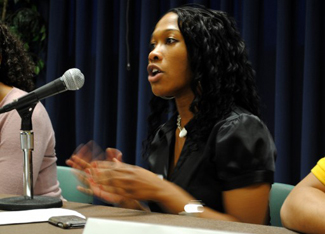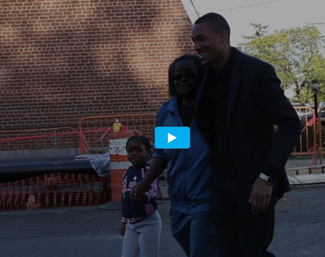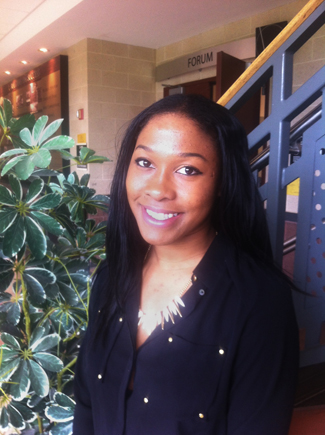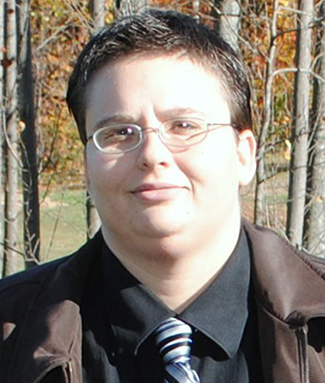
NEW YORK — Every time he combs his hair, Tomas Rios sees the scar.
It happened when he was 12 years old, his seventh year in the New York City foster care system. By then, he’d already shuffled through a few different neglectful and violent families. By then, it all felt like routine.
“I was living in one of the more abusive homes I’d ever been in,” Rios said. “I can’t remember what set it off.”
One kick from a foster parent’s work boot left the mark. Rios doesn’t think too much of it.
Still, painful foster care experiences motivate Rios to push for reform in his role as media and communications associate for Children’s Rights, a national organization that develops research, litigation and public policies to improve children’s welfare systems. For May, National Foster Care Awareness month, he wanted to attach real faces to the horrors of the system he survived.
“The numbers don’t really connect with people on an intimate level,” Rios said.
 Overwhelming statistics tell a grim story. More than 650,000 U.S. children experience foster care every year, and at least 23 states fail to meet federal standards intended to protect foster kids from abuse and neglect. On average, children stay in foster care for two years and experience three different homes, according to a 2012 report from the U.S. Department of Health and Human Services. But many foster kids have it much worse.
Overwhelming statistics tell a grim story. More than 650,000 U.S. children experience foster care every year, and at least 23 states fail to meet federal standards intended to protect foster kids from abuse and neglect. On average, children stay in foster care for two years and experience three different homes, according to a 2012 report from the U.S. Department of Health and Human Services. But many foster kids have it much worse.
“We’ve had kids in 10 or 20 placements,” Rios said. “No one would want their children to experience this.”
He helped create the Fostering the Future blog to give foster kids a forum and offer the public a glimpse into what he describes as a broken system. Launched to coincide with National Foster Care Awareness month, the blog presents a cross-section of foster children’s experiences.
Some of the bloggers had positive things to say about their time in the system, like loving families and protective social workers. Children’s Rights’ advocacy efforts have improved aspects of the system. In New Jersey, for example, 97 percent of children received medical exams within their first two months in the foster care system in 2011, compared with just 27 percent in 2008, thanks to Children’s Rights’ legal actions. Still, most of the bloggers wrote about their struggles.
Blogger Raven Profit (pictured at top and below) entered foster care as a high school freshman when her mother was diagnosed with mental illness. Now a senior at the State University of New York at Albany, Profit still remembers the bolt-locked refrigerator and mice at her foster home in Queens.

She remembers how hard she worked – taking night classes to keep her grades up, interning for a paralegal firm, co-captaining her gymnastics team – and how her efforts went unnoticed.
“What shocked me is that people don’t recognize the potential of foster kids,” Profit said. “You automatically become a victim.”
When she started college, Profit said she realized how lucky she’d been. Her high school gymnastics coach had pushed her to apply to competitive schools. The community college route, which most other adults had encouraged her to take, could have kept Profit embroiled in the system.
At age 21, foster kids in New York State are officially cut loose, but many leave the system when they turn 18 and take refuge in homeless shelters. Going away to college has given Profit a safe place to live for four years; some universities, like SUNY Albany, offer housing for foster kids during school breaks.
Several states offer tuition assistance for foster kids, and most qualify for Independent Student status, which can secure more financial aid. Still, many foster kids don’t even consider going away to college. They’re simply unaware of their options, Profit said, because overburdened caseworkers can’t devote enough time to each child.
When she learned that only 2 percent of foster kids earn a bachelor’s degree, Profit decided to get involved.
“My goal was to tell foster kids they could go to college for free,” Profit said.
She became an ambassador for Youth in Care Corner, a program that works with foster children throughout New York State. Profit talks to foster children about financial aid and the college application process, easing the burden on caseworkers who often can’t give them the individual attention she says they need.
Profit said she would like to see courts take more responsibility for helping children transition from foster care to adulthood. In the meantime, she said she’s doing her part to ensure that more foster children go to college, and fewer end up in public housing or shelters when they age out of the system. In three years, Youth in Care has worked with 700 youth in the foster care system and increased the number of bachelor’s degrees obtained by 1.5 percent over the New York State average.
“I’m very proud of it,” Profit said.
Children in the foster care system have been writing to Profit about her Fostering the Future blog post. Some have revealed how isolated they feel. Profit said she wants them to know there are other people who have gone through the same thing.
“There’s some good that can come out of it,” she said.
***
For blogger AJ Peters the transition from foster kid to young adult has been bumpy. She’s worked hard to find good in the bad – frequent moves, molestation and over-medication during a childhood spent in multiple foster homes – and believes her experience has made her a more compassionate person and better listener.
 “Everybody in my life showed me what type of person not to be,” Peters noted.
“Everybody in my life showed me what type of person not to be,” Peters noted.
She left the foster system when she turned 19, and stopped taking the psychotropic medications she’d been prescribed since her early teens. From there, she drifted between shelters in Tennessee and Virginia, working at fast food and restaurant jobs that never stuck.
Anxiety and recurring nightmares have made it impossible for her to keep a job. During one panic attack, she fell and landed on a grill.
“For ten years, I’ve been trying to prove that even though you went through what I did, you can still work,” Peters said. “And now I can’t work and I hate it.”
Peters plans to get back on medication, but worries about side effects; she remembers feeling like a zombie during her teens. Now that she lives with her girlfriend of two years in Tennessee, and has a close circle of friends, Peters fears that medication will interfere with her relationships and active lifestyle. When we spoke, she was out camping on the Tennessee River with people she loves.
“I want to be able to come out in the sunshine,” she said.
Writing has helped. Before she started blogging, Peters had only ever written about her foster care experience in her private journals and through poetry.
Despite her family’s reaction to her blog post Peters said she is glad she wrote.
“The kids who are still in there need people like us to say something,” Peters said. “I want kids to get to be kids, because that’s one thing the foster care system doesn’t let you do.”
She said she longs to meet her fellow bloggers and other former foster children, for a support group for adults who’ve endured the state care system.
“But trying to get the state to do that is like trying to get the state to admit they have a problem,” Peters said. “It’s not going to happen.”
Photo credits (from the top): Blogger Raven Profit speaking at a forum at John Jay College of Criminal Justice as ambassador for Youth in Care Corner (photo by John Jay College/CUNY); still from video on Jamel Robinson (video by Lindsay Armstrong and Erica Hochstedler); Raven Profit (photo courtesy Raven Profit); AJ Peters (photo courtesy AJ Peters).

























